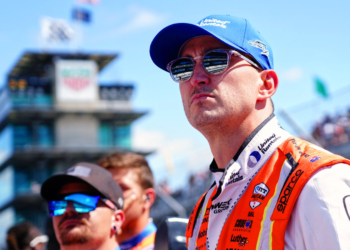You hardly can have missed that the Chinese Grand Prix just passed was the 1000th race ever in the Formula 1 world championship. And competing with this in the ubiquity stakes were the equally attention-demanding pedants. They had noticed that F1’s past is like any part of the truth: rarely pure and never simple.
Wherever you turned before, during and after the Chinese round there was an article or social media post pointing out – sometimes earnestly – that it wasn’t actually the 1000th F1 race. That there were Indianapolis 500s; two years of using Formula 2 regulations; blah de blah…
You’d imagine these guys are great at parties.
Yet there was something else that appeared in pedants’ corner. A few of them threw in F1’s non-championship races too.
These were exactly as described – races for F1 cars that did not provide points for the world championship table. And they used to be a frequent feature, to the point that F1 would have cruised past its 1000 total long ago had they been included. To take an extreme example for illustration, in 1962 there were nine grands prix counting towards the F1 championship. And how many non-championship F1 races were there that year? Twenty.
Further two of them were on the same day and in the same country. Mallory Park and Crystal Palace on June 11, since you asked.
As that indicates, Britain was particularly well-served by non-championship meetings generally; indeed fully eight of those 20 non-championship races in ‘62 were held in Blighty.
For years there were three regular non-championship F1 races in Britain on the schedule. The International Trophy at Silverstone taking place as an F1 event almost every year between 1949 and 1978; the Race of Champions (not to be confused with its modern day stadium-based namesake) at Brands Hatch which was first held in 1965 and last happened in 1983, and was the official British motorsport season curtain-raiser; while the Oulton Park Gold Cup existed as an F1 race on and off from 1954 to 1972.
As for why non-championship races existed, it all reflects F1’s conception. The grand prix long pre-dates the F1 world championship, with the first grand prix that in France in 1906 which was some 44 years before the championship came along (some extend it back even further and note a ‘Pau Grand Prix’ in 1901, though that was a city to-city loop rather than a circuit race of the sort we’d recognise today).
In 1962 there were nine grands prix counting towards the F1 championship. And how many non-championship F1 races were there? Twenty.
And when the F1 world championship started it picked but a small number of existing grands prix to provide points for the title. The inaugural world championship had six races (seven if you, yes, include the Indy 500), but they were very much in the minority, as in addition there were some 18 F1 races during 1950 that did not count towards the championship. And for years and decades that followed that’s how the landscape remained, with teams and drivers often keen to take part in championship and non-championship races alike to get their hands on some more prize money.
Non-championship races performed other roles too, such as acting as de facto test sessions and shakedown opportunities in an age wherein standalone test days were very rare. For this reason a lot of these races were scheduled in the spring.
Occasionally too the meeting acted as a dry run for a new circuit before it got onto the championship schedule proper. This was the case for Mexico City, Imola and Interlagos among others.
Non-championship races were popular as well. As the late journalist Alan Henry put it in 2013: “We loved ‘em! And just imagine how much you would still love ‘em now if, as you read this on the sunny Sunday of the May Day Bank Holiday weekend, instead you were en route to Brands Hatch or Silverstone or indeed even Oulton Park to watch a non-championship Formula 1 race involving Jenson Button, Checo Perez, Fernando Alonso, Felipe Massa, Seb Vettel, Mark Webber, Lewis Hamilton, Nico Rosberg, McLaren, Ferrari, Red Bull, Mercedes-Benz et al!”
There is of course always a risk of over-eulogising such things, and it’s certainly true that some of these races were rather risible affairs. Pity anyone who turned up to Vallelunga in mid-1972 for the Grand Prix of the Republic of Italy to find only seven cars to entertain them, and the same number of F1 cars proper were at the 1979 Race of Champions so the field had to be padded out with machines from the short-lived British F1 series.
Just imagine if you were en route to Brands Hatch or Silverstone to watch a non-championship Formula 1 race involving McLaren, Ferrari, Red Bull, Mercedes-Benz et al – Alan Henry
Some non-championship races were downright curious, not least in 1974 when the fraternity was invited to remain in Brazil for an extra week after the grand prix proper to attend a street race in Brasilia, put on for a variety of political reasons by the country’s then-President. He named the race after himself in case anyone didn’t get the message. As it was only half of the field took up the offer and the race was tepid. F1 machines never laid rubber on the place again.
But this was far from being the norm. Most of the greats of the time took part in non-championship races and many won them. Some of the drives have gone into folklore, such as Jochen Rindt’s 1969 Silverstone International Trophy effort as well as Lotus’s Jacky Ickx triumphing in the 1974 Race of Champions in Brands Hatch’s teeming rain, taking the lead from Niki Lauda’s Ferrari around the outside of Paddock.
Come the 1980s the non-championship race suddenly petered out however. Discounting two of them that were an offshoot of the FISA-FOCA war, the only post 1970s non-championship F1 race was the final Brands Hatch Race of Champions in 1983, which was won by Keke Rosberg’s Williams (giving Rosberg the distinction of having won both the final F1 International Trophy – which he took in torrential rain driving for Theodore in 1978 – and the final F1 Race of Champions).
And you can probably guess the reasons why these races died out. The commercial and prestige value of the F1 world championship grew over time and dwarfed other available races. The championship’s calendar has grown too, and that plus the advent of 24/7 testing meant non-championship races were harder to find space for. Plus drivers as precious commercial assets to be protected from unnecessary injury also grew in focus.
But what of today, where testing is severely restricted and – touch several pieces of wood – injury in action is much less common. Might the non-championship race have a role once more?
The plusses of such races would be almost never-ending. Of course, we fans would have more racing to watch.
Non-championship meeting would be the perfect place to try shorter races; having two races in a weekend a la F2; squeezing everything into a single day a la Formula E; qualifying races; reverse grids…
We can add that Liberty has been flying several kites on changing F1’s weekend format, and a non-championship meeting would be the perfect place to try innovations out. Shorter races; having two races in a weekend a la F2; squeezing everything into a single day a la Formula E; qualifying races; reverse grids… Perhaps even, purely for the sake of spicing up the non-championship races, you could apply some success ballast.
Think of the disastrous knockout qualifying from early 2016. Had that been tried – then quietly dropped – in a non-championship event rather than at F1’s actual curtain-raiser it would have been a lot less offensive.
There are plenty of other benefits too. Just like back in the day the race meetings could become effective test sessions and shakedowns, which surely would be welcomed by the teams in an age wherein as mentioned such opportunities are limited. Plus trying a new car, aero part, system or whatever in a race, as opposed to a test, surely would have more simulation value to teams given it’s a closer replication of a race weekend for real.
Equally sponsors surely would welcome the additional airing the races would provide; while circuits – and F1 itself – would welcome the additional ticket sales.
Non-championship races could also provide desperately-needed race opportunities for third drivers and others waiting patiently for their chance. Potentially a non-championship race rule could be that at least one nominal reserve or rookie pilot has to be raced.
So, with all that, just think if this weekend coming we had Esteban Ocon in a Mercedes alongside Lewis Hamilton to look forward to; Dan Ticktum in a Red Bull alongside Max Verstappen. At Imola.
Yet there are at least two conspicuous stumbling blocks; perhaps insurmountable ones. One is that with a 21-races-and-growing calendar (Liberty’s apparently pushing for 25) finding spare weekends to schedule non-championship races would not be the work of a moment. The size of the existing itinerary already is a bone of contention and your average F1 travelling circus member already spends 30 weeks or more of the year on the road. They’d be unlikely to welcome more.
Circuits having the ability to go off and hold a non-championship race instead would greatly reduce Liberty’s bargaining power
Perhaps non-championship races could be held during existing grand prix weekends (certainly Kyle Busch in NASCAR has no problem with taking part in several races in a weekend; neither did Stirling Moss back in the day). Failing that, perhaps they could be held instead of the existing scheduled test days?
These would head off the scheduling problem but would have the drawback of having non-championship races held at the same circuit that had just held or was just about to hold a championship race proper, thus depriving the non-championship race of a lot of its potential novelty.
The other stumbling block is likely even greater, as it’s to do with all-important commerce. Even in F1’s post-Bernie age, hosting fees are important and it’s in the interest of the commercial rights holders to have more potential hosts than calendar slots, making it a sellers’ market. Circuits having the ability to go off and hold a non-championship race instead would greatly reduce Liberty’s bargaining power. Even if you charged a hosting fee for the non-championship race, presumably a non-championship fee would necessarily have to be lower than one for real, and Liberty would not welcome being undercut.
With that, the non-championship F1 race may be one thing that has to remain in the past. And be argued about by pedants.






